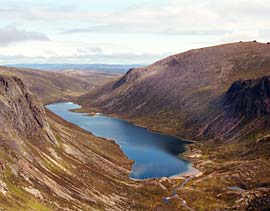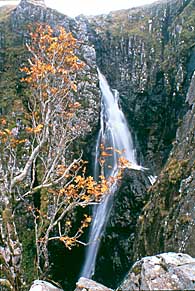With its mountains, pine-clad slopes and wide
river valley setting, Aviemore and the
Cairngorms area is yet another very
distinctive Highland setting.
 The high
plateau of the Cairngorms is a backdrop to
every view, and ever-changing throughout the
day as sun and shadow move across these high
hills. These high places lie at the core of
the Cairngorms National Park which, at 3800 sq
km, is the largest in Britain and was
established in 2003.
The high
plateau of the Cairngorms is a backdrop to
every view, and ever-changing throughout the
day as sun and shadow move across these high
hills. These high places lie at the core of
the Cairngorms National Park which, at 3800 sq
km, is the largest in Britain and was
established in 2003.
At a lower level, the area is also a
stronghold of the ancient Caledonian pinewoods
- the descendants of the natural forests of
old. As well as high mountain tundra and rocky
passes, moorlands and forest, there are also
extensive marshlands and lochs, whose
best-known visitor in summer is the osprey -
and one that is quite easy to spot,
particularly around the Boat of Garten area.
This is an area which has a huge range of
activities for visitors right through the
year. A chain of attractive little towns and
villages along the river valley, from
Grantown-on-Spey upstream to Dalwhinnie, make
good bases to discover the huge choice of
walking at all levels, the winter skiing at
Cairngorm, watersports and golf, plus the
equally wide range of visitor attractions,
which even includes the world's highest
distillery, and a steam railway with,
arguably, the best views of any preserved
railway in Britain.
Then there is the coast. Dazzling beaches by
Morar, endless sands by Nairn, Dornoch, Thurso
- and special, secret coves along the north
coast to Durness and beyond. The Clo Mor
cliffs (also by Durness) are the highest in
mainland Britain, the Stacks of Duncansby are
another icon of the north.
From the roadless wilds of Knoydart to the
gentle firths of the east, the natural
Highlands are a visual delight.
Beaches
Though lochs, glens and mountains may spring
first to mind, the Highland coastline is
equally spectacular and in many places the
rugged landscapes give way to superb, unspoilt
and mostly undeveloped beaches.
Perhaps the most famous of these are the White
Sands of Morar on the Road to the Isles.
However, travelling north around the coast
there are plenty more, with the Gairloch area
another noted location. Then there is a
further choice north of Ullapool at places
like Achmelvich (Gold Flag award), Clashnessie
and Clachtoll, as well as Sandwood Bay (which
even manages to be haunted as well!)
North West Highlands Geopark - a first for
Scotland
The Geopark is located in the far north of the
Scottish mainland in north west Sutherland and
Wester Ross and contains the villages of
Achiltibuie, Lochinver, Kinlochbervie, Scourie
and Durness.
What is a Geopark? It's a place where you will
experience the incredible legacy left by an
extraordinary geological past. The mountains
and coasts, the flora and fauna, the
communities that live here and their culture -
all owe a great deal to the difference which
this geology makes.
Waterfalls
With its mix of mountain, river and loch it
should come as no surprise that the Highlands
is home to most of Britain's most spectacular
waterfalls.
Don't just take my word for it, come and
enjoy Scotland too.
The north coast has some very special places:
small enclosed bays with dazzling white sands,
sometimes completely deserted - around Durness
or Melvich for example. Further east Dunnet
Bay, near Thurso is a two mile (three km)
stretch of golden sand well-known to surfing
enthusiasts.
 The east coast, facing into the Moray Firth,
also has some excellent and extensive
stretches, particularly south of Brora.
(Dornoch Beach, for instance, is a Blue/Gold
Flag commended beach.) There are also sandy
beaches on the Black Isle easily accessible
from Inverness, as are the extensive sandy
shores around the Moray Firth resort of Nairn
to the east.
The east coast, facing into the Moray Firth,
also has some excellent and extensive
stretches, particularly south of Brora.
(Dornoch Beach, for instance, is a Blue/Gold
Flag commended beach.) There are also sandy
beaches on the Black Isle easily accessible
from Inverness, as are the extensive sandy
shores around the Moray Firth resort of Nairn
to the east.
This is the most sparsely populated corner of
Europe, where the eagles and peregrines soar.
There's so much space - landscapes so ancient
our minds cannot begin to grasp the enormity
of time wrapped up in these rocks; quiet
glens, windswept summits and aquamarine waves
on gilded sands.
At 3,000 million years old, the rocks at the
seashore are even older than the hills - and
what hills they are. Where else can you
experience a skyline that compares to the
ridges of Foinaven and Arkle or classic hills
like Suilven or Stac Pollaidh?
Walk away your worries and cares; stay far
from the maddening crowd. Luxuriate in the
long light of a summer evening when night
never quite falls. There's space here in every
season.
This is a great place for walking, rambling,
climbing, angling, archaeology, music,
birdwatching, watersports, wildlife,
sight-seeing, history, quiet and
contemplation, genealogy, watersports and, of
course, geology. There are guided walks and
activities led by local Rangers and special
activity programmes during spring and autumn.
 The highest
falls in Britain, falling over 600 feet (200m)
are Eas a Chual Aluinn near Kylesku while the
largest single drop can be found at the Falls
of Glomach in Kintail which are over 400 feet
high. The falls of Glomach are fairly remote
requiring a round trip on foot of about while
Eas Chual Aluinn can be reached by a slightly
shorter 5 mile return walk but taking a boat
from Kylesku is a more common option. Steall
Falls in Glen Nevis or Plodda Falls near
Tomich are much shorter walks.
The highest
falls in Britain, falling over 600 feet (200m)
are Eas a Chual Aluinn near Kylesku while the
largest single drop can be found at the Falls
of Glomach in Kintail which are over 400 feet
high. The falls of Glomach are fairly remote
requiring a round trip on foot of about while
Eas Chual Aluinn can be reached by a slightly
shorter 5 mile return walk but taking a boat
from Kylesku is a more common option. Steall
Falls in Glen Nevis or Plodda Falls near
Tomich are much shorter walks.
Fortunately many other significant falls are
much more easily accessible - the Falls of
Measach in Corrieshalloch Gorge near Ullapool,
Divach Falls at Drumnadrochit, the Falls of
Foyers, Grey Mare's fall at Kinlochleven and
Pattack Falls near Laggan are all virtually at
the roadside while on Skye, Kilt rock and
Mealt Falls which drop straight into the sea
can be viewed from the clifftop carpark.
A number of other smaller falls, some taking
the form of steep rapids also attract many
visitors and often have path networks around
them - notable ones being Dog Falls in Glen
Affric, Rogie Falls near Contin, Moriston
Falls at Invermoriston or Shin Falls near
Lairg.